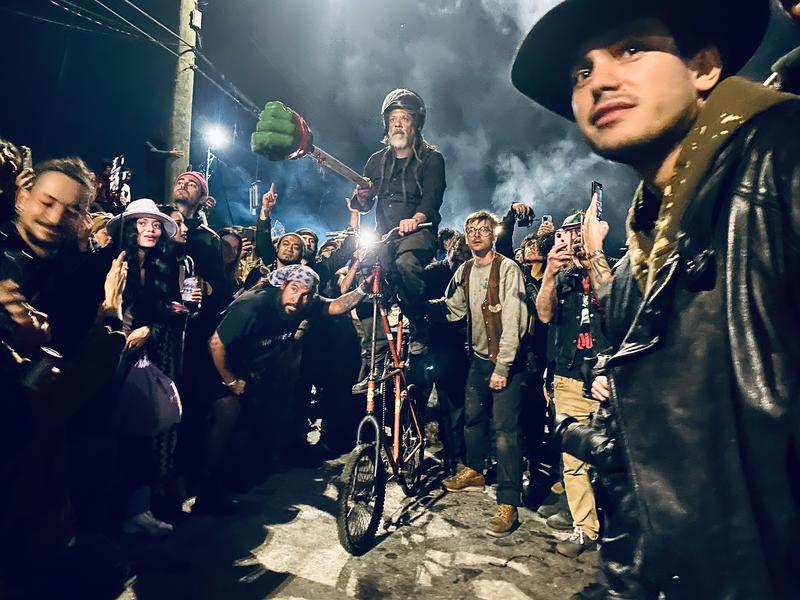100 Years of 100 Things: Street Photography

( Geralyn Shukwit )
[music]
Brian Lehrer: Brian Lehrer on WNYC. Now, let's continue our centennial series as WNYC has recently turned 100. It's 100 Years of 100 Things. We're up to thing number 87. Today, it's 100 years of street photography. Maybe you've seen the ads that camera maker Leica has been running celebrating the fact that its handheld 35 millimeter camera changed photography and made what we think of as street photography possible back in 1925.
To talk about how street photography developed and where it's headed, we're joined by Sam Barzilay, the creative director and co-founder of Photoville, the New York-based nonprofit working to promote a wider understanding and increased access to the art of photography for all with their exhibits. More on that later. You might recognize Photoville as our partner in our annual best photography on your phone contest that we do at the end of each year. Hey Sam, welcome back to the show. Welcome back to WNYC.
Sam Barzilay: Thanks, Brian. Good to be here. Thanks for having me.
Brian Lehrer: What was photography like before the Leica gained popularity 100 years ago in 1925?
Sam Barzilay: Well, if you have to imagine, like right now we think of cameras, we think of phones, we think of handhelds, maybe a DSLR, like a camera your dad has or I have. But before that, you were looking at large cameras on tripods, glass negatives, or maybe if you're a reporter, you had a Graflex which was like a two-handed, large flash bulb on top of it, like a beast. It was like probably 35, 40 pounds. You had to hold it up, take a photo, switch bulb, take another photo. It was a slog. The average person wasn't going to go out taking photos.
Brian Lehrer: Street photography, that term differs from documentary photography in that it's not just about capturing real life, but technology allows the element of chance.
Sam Barzilay: Absolutely. It's all about light and geometry, and just like these moments in time that you don't expect, you like-- It's a little bit about humor, but it's really about a moment in time. It's not about a story. As we think of documentary.
Brian Lehrer: Were there OG street photographers who established the art or the genre?
Sam Barzilay: Absolutely. André Kertész who was a Hungarian photographer who moved to Paris in a city bathed in light that we all know and a beautiful architecture, and his dream was to photograph it. He Got his hands on the first Leicas in the 1920s. At the beginning, of course, no one took him seriously because that was a thing no one did. It took a few years, I think, before he really got his first show, became famous. We always think anyone who takes free photography I'm one of them. I'm not a good street photographer, but I love it. You always look back and go, this was the beginning. Then it grows over the decades.
Brian Lehrer: Another one, maybe even more influential, was the French photographer Henri Cartier-Bresson, who coined the phrase the decisive moment. Talk about that.
Sam Barzilay: Absolutely. Cartier-Bresson is really the person who popularized street photography. When we, the general public, thinks of street photography, the image that comes to your head, that was probably a photo taken by Cartier-Bresson. Even he would admit that he owed everything to Kertész. Without him, there wouldn't have been a Cartier-Bresson. But really, he truly believed that--
He said that when he picked up his camera, he disappeared. The idea was to be almost like a fly on the wall. He had the small camera that no one really took seriously because they thought of cameras still as this big, heavy thing. He just waited for the right light, the right moment. Exactly. In that one instant, you caught this image that told a thousand stories.
Brian Lehrer: Listeners, we can take a few phone calls. Do you want to shout out an iconic photograph that captured that decisive moment? What adventures have you had as a street photographer yourself or as somebody who likes to look at street photography? 212-433-WNYC, 212-433-9692. I'll just throw in Sam, that as it happens, I just went to see a street photography exhibit on Sunday. It was the Women's Street Photographer Show at Artspace PS109 on East 99th Street. It's still up.
One of the things I was keying on was that each image they displayed had a little story posted alongside in which the photographer described something about how they stumbled on the shot, I guess the decisive moment, or what kinds of things they like to look for. So often it's people and the looks on their faces. I was thinking about how it's not just cool found visuals that many street photographers are going for, though it's certainly about the visuals, but an openness to human experiences and human emotions as expressed visually that draws street photographers in many cases.
I wonder if you think about that, the connection to the people in the shots, even if they never strike up a conversation with them, which they often don't, as well as how compelling an image it is.
Sam Barzilay: Oh, 100%, Brian. As you said, it's not just the moment, it's also that connection. In fact, a lot of photographers a little bit later in the years, for example, Robert Frank in the '50s, going around America because he was a Swiss American photographer, he went around the country because he really wanted to understand that moment in time for America. He, in fact, got arrested for congregating with the wrong people in very large [00:05:41] quotes in Alabama.
It was this thing of like wanting to humanize, wanting to show people for who they are. A lot of times, photographers actually did strike up not just a moment's conversation, but relationship that lasted 20 years. In fact, Diane Arbus was one of those people that in the '60s and even before she followed people and she really changed what we thought of as acceptable subjects to photograph. Again, seeing this idea of a humanist eye in street photography.
Brian Lehrer: Right. As we talk about this hundred-year timeline, Robert Frank was big post-war. There's also something to say about the World War II era itself, when photojournalists were capturing these "decisive moments" as urban streets became theaters of war.
Sam Barzilay: Absolutely. Again, having a 35 millimeter camera you could take into a war zone that was a game changer. Robert Capa, obviously one of those famous photographers, street and war both, and co-founder of Magnum Photos, most famous photo agency. Both Spanish Civil War and World War II, he was there with his 35 millimeter Leica. It was an incredible what he was able to capture. Literally moments as someone mid-air, falling from a bullet, a photo that could never have been captured with an older camera.
Brian Lehrer: On Robert Frank in the '50s, it was important that he was looking at Americans with an outsider's eyes. Like de Tocqueville maybe. Right?
Sam Barzilay: Exactly. For him it was coming with fresh eyes, not with all the baggage, all the legacy of being an American or having feelings one way or another about what's happening and traveling around the country looking at injustice, looking at racial inequality, but really telling the story of America in the joy, in the patriotism, in the inequality, every part of it. He shot 28,000 photographs to make one book. It's an incredible feat.
Brian Lehrer: Continuing up the timeline, you mentioned Diane Arbus. If we talk about the 1960s and '70s, there was so much cultural revolution in the air. Was it reflected in street photography?
Sam Barzilay: 100%. Diane Arbus, of course, a giant in this world of street photography. Again, she started photographing people who had before been shunned, who were not "acceptable" subjects to be photographed, who are marginalized. She raised that issue of who are we as a society? So many people, Jill Friedman, Helen Levitt, in that era, all walked alongside her in those steps. But also you see that continuing into the '70s, into the '80s. I will say New York City, that we're all in, some of us are in, really has always been almost like another character in these photos. It feels like it has a presence in the photograph, not just architecture; it sets the scene.
Brian Lehrer: By the '80s, Jamel Shabazz, I know you want to mention Jamel Shabazz, who you, I think have a relationship with and was a self-taught Rikers prison guard, right?
Sam Barzilay: Correct. This was his way of showing in a New York in the '80s that was not in its best shape, that a lot of communities were being destroyed by mass incarceration, by drugs flooding the streets. He wanted to show there was joy, there was family, there was community.
He photographed in the lower side in Brooklyn. These are photos full of such love and joy. We have the honor of having him be on our board. We met him so many years ago because he was part of an exhibit we did, one of our first exhibits Photoville ever did. Honestly, he exudes this love for his fellow man. I also want to shout out Arlene Gottfried, a photographer also in the same era, '70s and '80s, also known as singing photographer.
She passed away a few years ago, unfortunately, but she never really got a lot of recognition. But again, she was able to capture so many communities who are usually overlooked, but in such a beautiful, loving light. She developed this relationship with, whether it was street performers or little kids, it was an incredibly two-way relationship. Not just I'm going to take this photograph and walk away.
Brian Lehrer: Street photographer Maggie in Manhattan calling in. You're on WNYC. Hi, Maggie.
Maggie Hopp: I'm Maggie Hopp. I photographed Times Square in the '70s and '80s, and '90s. My work is in the Historical Society and I am of the generation post Robert Frank, who we discussed things like being concerned photographers, not just street photographers, documentary, personal, editorial, but also concern photography seemed to be what we were about. People like Gary Renaud and Charlie Biasini, and the last gasp of Life Magazine, people. We're all about that. Arlene Gottfried, by the way, has a show at the New York Historical Society on 77th street right now.
Brian Lehrer: I mentioned that I saw the Women's Street Photographers exhibit on Sunday at Artspace PS109, and there was some language posted about this. But I wonder if you have any thoughts on whether there's a particular not to overgeneralize, but women's eye that's worth describing in your experience, or if women have a different relationship to wandering city streets safely than men might and that affects their street photography.
Maggie Hopp: Absolutely. Back in the '70s, I did a project called Stoop Sitters, and I photographed people sitting on stoops all over the city in all the different neighborhoods. At that time, a woman alone walking the streets was a novelty. People were related to me in an instant, and they were flattered that I was taking their pictures. Those images are iconic of a time you wouldn't find them today because everybody's buried in their phone looking down and all. Today, people had no place to go when it was hot. They went outside and sat on their stoops, and they had a community and a relationship with the life on the street.
Brian Lehrer: I'm going to leave it there, Maggie. I really appreciate it. By the way, you said your full name at the beginning, but your phone broke up on your last name. If you want people to hear your full name, you can say it again if you want.
Maggie Hopp: You want Maggie Hopp.
Brian Lehrer: Thank you very much, Maggie. Sam, what about the advent of the cell phone? How has that changed street photography because it's so accessible? Has it changed the art form for the people who are really into?
Sam Barzilay: It really has. I say in good ways and in bad ways. On one hand, I'm always going to be on the side of more access to people. The cost of a digital camera is a fraction of what it was. A fraction of a film camera. Obviously, it opened up so many people who are self-taught or just wouldn't have had money to buy an expensive camera. As we live in this world, like Maggie said, we're all looking at our phones.
We are looking, but we are not actually paying attention. I feel we take so many more photos, but we're not ever going back. When you had film, you had 36 frames. Those are going to cost you money to buy the film, to develop, to print. You were going to think about those photos. You're going to print a context sheet. You're going to pour over every frame to try and circle the ones you thought, oh, this is really going to be a good one.
Now I have 70,000 photos on my phone. I don't know that I've ever really paid attention. What are they? That worries me that we're losing that patience. I think street photography requires such a keen eye for recognizing a moment and a light, and a situation forming. You can catch it if you're looking at your phone. You're not seeing the world around you. You're not actually seeing those moments.
Brian Lehrer: Before you go, I want to give you the opportunity to shout out some of your own organization's work. Photoville, which is known for making photography accessible through its exhibit. Does street photography play a big role in the work that you display, and you can invite people to get involved?
Sam Barzilay: Absolutely. We try to show all kinds of photography. We do have our annual photo festival, which is in our home in Brooklyn Bridge Park, as well as parks around the City, opening June 7th and 8th. We're at Photoville NYC, but I also want to shout out, we're actually about to open a show on street photography in the 100 years of street photography, as it happens on May 1st at the Meetpacking District, partnering with Leica, actually celebrating their 100 years. We couldn't not do that. It's just such an iconic moment. We'll have a show up for a week at the Meatpacking District. It's totally worth seeing.
Brian Lehrer: A perfect way to wrap up this 100 Years of 100 Things segment. Thing number 87, 100 years of street photography. 100 years after the Leica began to make it possible with Sam Barzilay, the creative director and co-founder of Photoville. Sam, thanks so much.
Sam Barzilay: Thank you so much, Brian. Always a pleasure.
Brian Lehrer: That's The Brian Lehrer show for today, produced by Mary Croke, Lisa Allison, Amina Serna, Carl Boisrond, and Esperanza Rosenbaum. Zach Gottehrer-Cohen produces our daily politics podcast. Our intern this term is Henry Saringer. Megan Ryan is the head of Live Radio. Juliana Fonda and Milton Ruiz at the audio controls. You can sign up for free for The Brian Lehrer Show newsletter if you're interested. It includes a weekly column from me, a reader question for you to answer if you choose, and some other features to sign up. Just go to wnyc.org/blnewsletter and it'll come to your inbox every Thursday afternoon. Talk to you tomorrow, Brian Lehrer on WNYC. Now, stay tuned for Allison.
Copyright © 2025 New York Public Radio. All rights reserved. Visit our website terms of use at www.wnyc.org for further information.
New York Public Radio transcripts are created on a rush deadline, often by contractors. This text may not be in its final form and may be updated or revised in the future. Accuracy and availability may vary. The authoritative record of New York Public Radio’s programming is the audio record.

